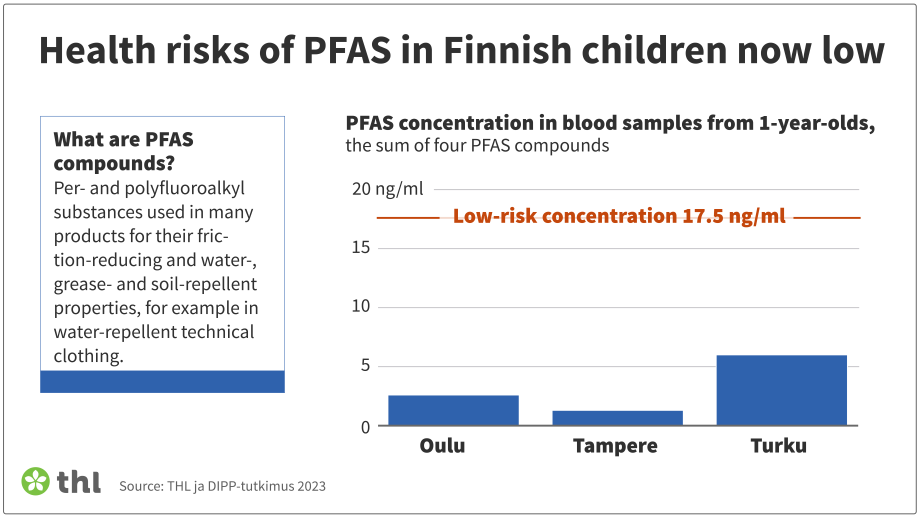Levels of most harmful PFAS compounds low in Finnish children but differences between localities exist
The exposure of Finnish children to PFAS is well below the limit for low risk, according to a THL study on the exposure of 1-year-old Finnish children to the four most harmful PFAS compounds.

PFAS (Per- and Polyfluoroalkyl Substances) compounds are used in many consumer products. Some of the best-known applications are ski greases, non-stick coatings for frying pans and water-repellent technical clothing. In addition, PFAS materials are resistant to heat, cold and strong chemicals, which is why they are also widely used in industrial machinery and processes.
The THL project examined a total of 300 blood samples taken during 2020 from 1-year-old children in Turku, Tampere and Oulu.
The average PFAS levels in blood samples from children collected in the Turku region were about five times higher than in Tampere and more than twice as high as in Oulu. However, in all cities, concentrations were well below the low-risk level set by the European Food Safety Authority (EFSA).
“The reasons for the differences between areas are not known and are now also the subject of further research. However, the concentrations are below the limit for low risk," says THL Research Manager, Panu Rantakokko.
In 2020, EFSA estimated that the sensitive adverse effect of PFAS is reduced vaccine efficacy in children. At higher concentrations, population studies have also found associations with elevated cholesterol and liver function, but the evidence is less clear.
Concentrations of PFAS in children down since last measurement – health risks low
PFAS levels in Finnish 1-year-old children were previously only measured in a small sample of children born in 2005 in Kuopio. At that time, about one-third of children exceeded the concentration limit for low risk. As all of the four most harmful known PFAS compounds have been restricted in the EU since 2005, THL wanted to determine the current concentrations in relation to the low-risk limit.
In the data of children born in 2019, the concentrations in blood samples of 1-year-old children were about 80% lower than in the data of 1-year-old children born in 2005 in Kuopio. The results suggest that the health risks of PFAS in Finnish children are currently low.
Further studies will use background data collected from children to investigate the factors influencing the PFAS concentrations in their blood.
The use of PFAS on an industrial scale began in the 1950s, but their harmful properties to health and the environment were not widely recognised until the turn of the millennium. There are thousands or even millions of PFAS compounds depending on the definition, but the effects of only a small proportion of these on humans are well known.
Many of the most harmful PFAS substances have been severely restricted and replaced by less harmful compounds. However, exposure to harmful PFAS compounds can continue long after restrictions have been imposed as, once in the body, they remain there for many years.
More information:
Per- and polyfluoroalkyl substances in the serum of 1-year-old children (PFLAPSET) project (in Finnish)
Are you concerned about PFAS compounds? – Come to the National PFAS Webinar on 10 January 2024 (in Finnish)
Panu Rantakokko
Research Manager
THL
Tel. +358 29 524 6395
firstname.lastname(at)thl.fi



